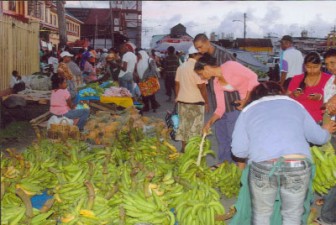Six nights a week, while most of the city sleeps or pursues its alternative nocturnal activities, the Georgetown ferry stelling, more particularly an area just north of the headquarters of the Guyana Fire Service, becomes a hive of commercial activity.
Under cover of darkness, agricultural produce and money change hands. All night long, buyers and sellers comprise one of the largest coastal markets in the country.

The buyers and sellers come from far and wide; trucks laden with farm produce ranging from ground provision to green vegetables pull into the area from early afternoon. The facility provides mostly for wholesale vending, but quite a few intrepid housewives take their chances, aware of the considerable savings that can be realized from shopping there.
On every trading day, as many as 100 vendors show up with their loads. They come from the Essequibo Coast and Islands, the Soesdyke/Linden Highway, Linden, Laluni, Berbice, Canals Number One and Two, East Coast Demerara and Mocha and they come prepared to do business.
Acting Deputy Clerk of Markets Simone McKend told Stabroek Business that trading is set to take place from 23:00 hrs and 07:00 hrs from Monday to Saturday but that business commences much earlier in the evening. As early as around 18:00 hrs, the vendors arrive as do the buyers. Whenever the two sides meet and are prepared to do business that is when the trading starts.
This is as good a market as any from which to secure an appreciation of the role that agriculture plays in Guyana’s economy. Tons of ground provision, plantains, avocadoes, coconuts, oranges, limes, pumpkins, peppers, papaws and lemons occupy every available space. Piles of calaloo, okra, boulanger, and pak choy are also on display and even as brisk trading ensues more produce arrives by boat across the Demerara River and by truck.
Leroy Henry, originally a resident of Wakenaam but now living in Sophia, is a regular wholesale buyer. He makes his purchases of cassava, plantain and eddoes from the wholesale vendors and does his own retailing mostly on Sundays. Henry is one of those buyers who avoids the late night clamour. He begins to do business as early as 17:00 hrs.
A citrus vendor from Kuru Kururu declines to give his name but says he brings limes, lemons and oranges from his farm on the Soesdyke-Linden Highway. Sometimes he purchases from another farm at Laluni. He has been trading here from early evening for the past six years.
Then there was a young woman, a vendor from Kuru Kuru too. She puts in an appearance at the market at around 02:00 hrs. She arrives in a minibus bringing with her between eight and ten bags of eddo-leaf calaloo. The calaloo is chopped and packed into smaller plastic bags which are retailed for $100 each. Eddo-leaf calaloo is usually in high demand and by day clean, she has sold out and is ready to go. It’s good business. Her fee for trading is $100; the cost of a single bag of chopped up eddo leaf calaloo. Apart from that she rents a pallet from a private operator on which to store her produce. The cost is $200.
McKend says the facility was established several years to facilitate a wholesale outlet for farmers. In a particularly congested section of the city, however, it has expanded beyond its originally set boundaries. On Fridays, when trading officially begins in the afternoon, the market usually extends towards Cornhill Street in front of the old Guyana National Co-operative Bank. It seems as though a cash-strapped municipality conveniently turns a blind eye on the traders’ indiscretion.
Women traders often outnumber their male counterparts in the market. Another female farmer and wholesaler from Bee Hive, East Coast Demerara, told Stabroek Business that she began trading leaving their farms behind. The scarcity of fruit has forced Ramanan to increase the scale of his own cultivation. He is currently cultivating cherries, bananas, sugar cane, coconuts and plantains on 30 acres of land at Grant Burthrum in the Upper Pomeroon.
Ramanan says he is concerned that unless steps are taken to arrest the increasing migration to the interior resulting from the ‘gold rush’ farming on the Essequibo Coast will be in crisis. His concerns will be hard to sell, however. During our visit to the Essequibo Coast we met a young woman, a former employee of Original Juice, who told us that she now earns $300,000 every six weeks as a cook in a mining camp.
Over time, Ramanan has enhanced his personal capacity to manage his business enterprise. He has attended management courses at the Kuru Kuru Cooperative College. Subsequently, he attended two Food and Drink exhibitions in Toronto arising out of which he has identified what he believes are new potentially lucrative markets. Whether or not he takes the plunge into the export market again will also depend on the availability of air cargo transport.
For the time being, Ramanan is content with being a big fish in a more modest local pond. Hard work has resulted in the penetration of markets at Port Kaituma, Moruca, Wakapoa and the Pomeroon River. The Essequibo Coast has long been a captive market. He is currently dialoguing with Sterling Products Ltd with a view to entry into the urban market.
Ramanan says he has had enquiries from Caribbean territories regarding possible regional exportation. He insists, however, that he will not pursue those enquiries unless he is persuaded of the reliability of intra-regional cargo flights.
Two agents supply bottles for the juices; one imports them from Suriname.
Ten years ago, Original Juice was decorated with the Best Manufacturer Award by the Institute of Private Enterprise Develop-ment (IPED). Last November, the enterprise received the President’s Award from the Guyana Manufacturing and Services Association for its contribution to the agro-processing sector. Recognition weighs heavily on Ramanan’s shoulders, pushing him towards ever higher standards.









